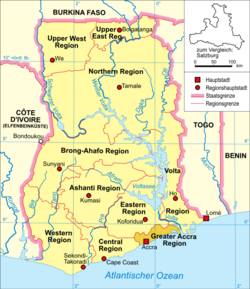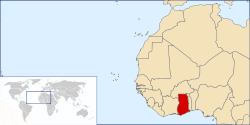Accra
| Accra, Ghana | |
| Map of Ghana showing the location of Accra. | |
| Coordinates: {{#invoke:Coordinates|coord}}{{#coordinates:5|33|00|N|0|12|00|W|type:city | |
|---|---|
| name= }} | |
| District of Ghana | Accra Metropolis District |
| Government | |
| - Chief Executive | Stanley N. A. Blankson |
| Area | |
| - City | 185 km² (71.4 sq mi) |
| - Metro | 200 km² (77.2 sq mi) |
| Elevation | 61 m (200 ft) |
| Population (200) | |
| - Urban | 2,200,800 |
| - Metro | 2,905,726 |
| estimated | |
| Time zone | GMT (UTC) |
| - Summer (DST) | Not used (UTC) |
| Website: www.ama.ghanadistricts.gov.gh | |
Accra is the capital, the largest city, and the administrative, communications, and economic centre of Ghana. Located on the Gulf of Guinea in the Atlantic Ocean, the city sits partly on a cliff, 25 to 40 feet (eight to 12 metres) high, and spreads north over the Accra plains.
The city of Accra has been Ghana's capital since 1877, and contains fine public buildings reflecting its transition from a 19th century suburb of Victoriasborg to the modern metropolis it is today. Spreading along the Atlantic coast, the city is well endowed with luxury as well as great value hotels, excellent restaurants and nightclubs, a range of museums, fine public monuments, modern business and commercial areas, as well as busy markets and tree-lined residential suburbs.
Geography
The word Accra is derived from the word Nkran meaning "ants" in Akan, a reference to the numerous anthills seen in the countryside around Accra.
The almost flat and featureless Accra plains descend gradually to the gulf from a height of 150 meters. The topography east of the city of Accra is marked by a succession of ridges and valleys. In the west of Accra, the low plains contain broader valleys, and round, low hills with a few rocky headlands. Mostly however, the land is flat and covered with grass and scrub. Thick patches of coconut palms dot the coastline.
The city lies within the coastal-savannah zone. Low annual rainfall averaging 810mm distributed over less than 80 days. The main wet season falls between the months of March and June, and a minor rainy season around October.
The mean temperatures vary from 24 ºC in August to 27 ºC in March. The Odaw River is the main river that flows through Accra. Accra’s main water supply is from the Weija Dam on Densu River with some water being pumped from the Akosombo dam in the Volta River.
Accra covers an area of about 170 km²
Accra's low elevation, the clayish nature of its soil, inadequate and undersized drains, and the dumping of refuse into drains and water bodies contributes to flooding every year.
History
Portuguese settlers in 1482, found the present site of Accra occupied by villages of the Ga tribe, ruled from Ayaso, which was located about 15 miles (24km) north. Between 1650 and 1680 the English built Fort James, a fortified trading posts, the Dutch built Fort Crevecoeur, and the Danish—built Christiansborg Castle.
At that time, Ayaso was destroyed in a tribal war. The prospect of profitable trade with the Europeans, drew to the coast the Ayaso population, with that of the other Ga towns. Coastal villages grew around the three fortified trading posts — Osu around Christiansborg, Accra (later Ussher Town) around the Dutch fort, and James Town. These were the centres of what was to become Accra.
During part of its history, Accra served as a centre for trade with the Portuguese, who built a fort in the town, followed by the Swedish, Dutch, French, British and Danish by the end of the seventeenth century.
The site of present-day Accra developed into a sizable town around the original Ga town as well as British, Danish and Dutch forts and their surrounding communities: Jamestown near the British fort, Osu near the Danish Christianborg fort (now Osu Castle) and Ussherstown near the Dutch Ussher fort. The four areas form the core of the modern city.
In 1877, at the end of the second Anglo-Asante War, Accra replaced Cape Coast as the capital of the British Gold Coast colony. After the completion of a railway to the mining and agricultural interior, Accra became the economic centre of Ghana. Large areas were destroyed by earthquakes in 1862 and 1939, but the city grew around a seaport (now relocated to Tema), and later a brewery, expanding into neighbouring towns.
The Accra Riots in 1948 launched the Ghanaian campaign for independence, which led to the Ghana's independence from the United Kingdom and nationhood in 1957.
Today, Accra is one of the wealthiest and most modern cities in the African continent, with a high quality of living by African standards. Accra is also known as having one of the continent's most active night life.
Administration
The Greater Accra Region is the smallest of the constitutional democracy of Ghana's 10 administrative regions in terms of area, occupying a total land surface of 3,245 square kilometres or 1.4 per cent of the total land area of Ghana. Under the local government system, the region is divided into five districts: the Accra Metropolitan Area, Tema Municipal Area, Ga East District, Ga West District, Dangme West District, and Dangme East District. Each district, municipal or metropolitan area, is administered by a chief executive, representing central government but deriving authority from an assembly headed by a presiding member elected from among the members themselves.
Economy
Well endowed with natural resources, Ghana has roughly twice the per capita output of the poorest countries in West Africa.
The primary economic activities are financial and government services, communications, construction, transport and agriculture (particularly fishing). Over 70% of Ghana's manufacturing capacity is located within the capital area. [1]
Accra is a major transport hub, home to the Kotoka International Airport and lies on railway lines to the port city of Tema, 17 miles (27km) to the east, Takoradi and Kumasi, in the interior.
Accra has well-paved roads. Public transit is provided by a mix of privately owned Mini-buses (known as Tro-Tros), taxis and buses. Tro-Tros are usually converted Mini-buses that run a regular, well-known route. They are cheap and frequent but often in poor repair and over-crowded. Some taxis also run regular routes, which cost more but provide for a more comfortable ride. Recently in 2002, the city introduced metro bus services, which were initially met with scepticism by commuters, but have increased in popularity.
Demography
Accra had population of 1,970,400 in 2005.
In terms of population, however, the greater Accra Region is the second most populated region, after the Ashanti Region, with a population of 2,905,726 in 2000, accounting for 15.4 per cent of Ghana’s total population.
Population rank of 155 in the list of world urban areas, according to Demographia.
On Accra's outskirts are Achimota Secondary School which was founded in 1924 and opened in 1927, and Presby Boys' Secondary School and some of the country's leading secondary schools and, 13km north at Legon, the University of Ghana, with its distinctive buildings set among elegant tree-lined gardens.
In Cantonments, you'll find Ghana International School (GIS), a private non-profit A- Level school founded in 1955 for children from ages 3-18. Abelemkpe is the home of Lincoln Community School, Accra Ghana (LCS). LCS is also a private, non-profit International Baccalaureate school for students aged 3-18, and was established in 1968. The Defence Commission of the Organization of African Unity has its headquarters in Accra.
Attractions
the Centre for National Culture, Independence Square, the Kwame Nkrumah Mausoleum, the Accra International Conference Centre, the fishing port at James Town and Makola Market.
Accra is home to the National Museum of Ghana, with its display of exhibits that reflect the heritage of Ghana from prehistoric times to modern times, the Ghana Academy of Arts and Sciences, the National Archives of Ghana, and Ghana's central library. Also of note is Christianborg or Osu Castle—the residence of the president of Ghana, built by the Danes in the 17th century, the National Theatre, with its distinctive modern architecture, Accra Centre for National Culture, a lighthouse, the Ohene Djan Stadium, the Accra International Conference Centre, the W.E.B. DuBois Memorial Centre for Pan-African Culture and several beaches. Near the Parliament of Ghana is the Ghana-India Kofi Annan Centre for Excellence in ICT.
The Kwame Nkrumah Memorial is located in downtown Accra.
ReferencesISBN links support NWE through referral fees
- Pellow, Deborah. 2002. Landlords and lodgers socio-spatial organization in an Accra community. Westport, CT: Praeger. ISBN 9780313012396
- Parker, John. 2000. Making the town: Ga state and society in early Colonial Accra. Social history of Africa. Portsmouth, NH: Heinemann. ISBN 9780852556436
- Obosu-Mensah, Kwaku. 1999. Food production in urban areas: a study of urban agriculture in Accra, Ghana. Aldershot: Ashgate. ISBN 9780754610298
- Nadeau, Jennifer E. 2000. Power lines: how commercial popular culture is creating a new public sphere in Accra, Ghana. Thesis (Ph. D.)—American University, 2000. OCLC 187893161
External links
- World Urbanized Areas Demographia, accessed June 16, 2008.
- Accra Encyclopaedia Britannica, accessed June 16, 2008.
- Ghana World Fact Book, accessed June 16, 2008.
- Accra RUAF Foundation, accessed June 16, 2008.
- Greater Accra Region Ghana Districts.com, accessed June 16, 2008.
- Latest Accra News
- Map of Accra
- Google Earth image of Accra, Ghana
Credits
New World Encyclopedia writers and editors rewrote and completed the Wikipedia article in accordance with New World Encyclopedia standards. This article abides by terms of the Creative Commons CC-by-sa 3.0 License (CC-by-sa), which may be used and disseminated with proper attribution. Credit is due under the terms of this license that can reference both the New World Encyclopedia contributors and the selfless volunteer contributors of the Wikimedia Foundation. To cite this article click here for a list of acceptable citing formats.The history of earlier contributions by wikipedians is accessible to researchers here:
The history of this article since it was imported to New World Encyclopedia:
Note: Some restrictions may apply to use of individual images which are separately licensed.
- ↑ Formal Economy - Retrieved December 10, 2007.

